Thalamocortical Up states: differential effects of intrinsic and extrinsic cortical inputs on persistent activity
- PMID: 17442810
- PMCID: PMC6672324
- DOI: 10.1523/JNEUROSCI.0003-07.2007
Thalamocortical Up states: differential effects of intrinsic and extrinsic cortical inputs on persistent activity
Abstract
During behavioral quiescence, the neocortex generates spontaneous slow oscillations that consist of Up and Down states. Up states are short epochs of persistent activity that resemble the activated neocortex during arousal and cognition. Although Up states are generated within the cortex, the impact of extrinsic (thalamocortical) and intrinsic (intracortical) inputs on the persistent activity is not known. Using thalamocortical slices, we found that the persistent cortical activity during spontaneous Up states effectively drives thalamocortical relay cells through corticothalamic connections. However, thalamic activity can also precede the onset of cortical Up states, which suggests a role of thalamic activity in triggering cortical Up states through thalamocortical connections. In support of this hypothesis, we found that cutting the connections between thalamus and cortex reduced the incidence of spontaneous Up states in the cortex. Consistent with a facilitating role of thalamic activity on Up states, electrical or chemical stimulation of the thalamus triggered cortical Up states very effectively and enhanced those occurring spontaneously. In contrast, stimulation of the cortex triggered Up states only at very low intensities but otherwise had a suppressive effect on Up states. Moreover, cortical stimulation suppressed the facilitating effect of thalamic stimulation on Up states. In conclusion, thalamocortical inputs facilitate and intracortical inputs suppress cortical Up states. Thus, extrinsic and intrinsic cortical inputs differentially regulate persistent activity, which may serve to adjust the processing state of thalamocortical networks during behavior.
Figures
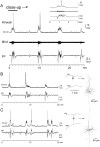

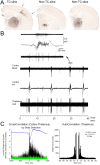


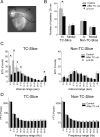
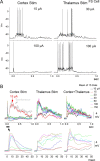
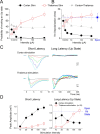

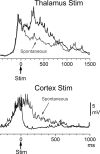
Similar articles
-
Impact of persistent cortical activity (up States) on intracortical and thalamocortical synaptic inputs.J Neurophysiol. 2009 Jul;102(1):119-31. doi: 10.1152/jn.00126.2009. Epub 2009 Apr 29. J Neurophysiol. 2009. PMID: 19403750 Free PMC article.
-
Synaptic cooperativity regulates persistent network activity in neocortex.J Neurosci. 2013 Feb 13;33(7):3151-63. doi: 10.1523/JNEUROSCI.4424-12.2013. J Neurosci. 2013. PMID: 23407969 Free PMC article.
-
Cortical up and activated states: implications for sensory information processing.Neuroscientist. 2009 Dec;15(6):625-34. doi: 10.1177/1073858409333074. Neuroscientist. 2009. PMID: 19321459 Free PMC article. Review.
-
UP states protect ongoing cortical activity from thalamic inputs.PLoS One. 2008;3(12):e3971. doi: 10.1371/journal.pone.0003971. Epub 2008 Dec 18. PLoS One. 2008. PMID: 19092994 Free PMC article.
-
Synchronized activities of coupled oscillators in the cerebral cortex and thalamus at different levels of vigilance.Cereb Cortex. 1997 Sep;7(6):583-604. doi: 10.1093/cercor/7.6.583. Cereb Cortex. 1997. PMID: 9276182 Review.
Cited by
-
Large-scale cortical dynamics of sleep slow waves.PLoS One. 2012;7(2):e30757. doi: 10.1371/journal.pone.0030757. Epub 2012 Feb 17. PLoS One. 2012. PMID: 22363484 Free PMC article.
-
Modulation of Synaptic Plasticity in the Cortex Needs to Understand All the Players.Front Synaptic Neurosci. 2017 Feb 1;9:2. doi: 10.3389/fnsyn.2017.00002. eCollection 2017. Front Synaptic Neurosci. 2017. PMID: 28203201 Free PMC article. Review.
-
Recovery of consciousness after brain injury: a mesocircuit hypothesis.Trends Neurosci. 2010 Jan;33(1):1-9. doi: 10.1016/j.tins.2009.11.002. Epub 2009 Dec 1. Trends Neurosci. 2010. PMID: 19954851 Free PMC article. Review.
-
Differentiated participation of thalamocortical subnetworks in slow/spindle waves and desynchronization.J Neurosci. 2012 Feb 1;32(5):1730-46. doi: 10.1523/JNEUROSCI.4883-11.2012. J Neurosci. 2012. PMID: 22302813 Free PMC article.
-
Dynamics of coupled thalamocortical modules.J Comput Neurosci. 2010 Jun;28(3):605-16. doi: 10.1007/s10827-010-0244-5. Epub 2010 May 20. J Comput Neurosci. 2010. PMID: 20490643
References
-
- Agmon A, Connors BW. Thalamocortical responses of mouse somatosensory (barrel) cortex in vitro. Neuroscience. 1991;41:365–379. - PubMed
-
- Alonso JM, Usrey WM, Reid RC. Precisely correlated firing in cells of the lateral geniculate nucleus. Nature. 1996;383:815–819. - PubMed
-
- Anderson J, Lampl I, Reichova I, Carandini M, Ferster D. Stimulus dependence of two-state fluctuations of membrane potential in cat visual cortex. Nat Neurosci. 2000;3:617–621. - PubMed
-
- Benshalom G, White EL. Quantification of thalamocortical synapses with spiny stellate neurons in layer IV of mouse somatosensory cortex. J Comp Neurol. 1986;253:303–314. - PubMed
-
- Bezdudnaya T, Cano M, Bereshpolova Y, Stoelzel CR, Alonso JM, Swadlow HA. Thalamic burst mode and inattention in the awake LGNd. Neuron. 2006;49:421–432. - PubMed
MeSH terms
Grants and funding
LinkOut - more resources
Full Text Sources
